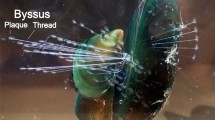Summary
Marine mussels secrete a byssus in order to attach to solid surfaces in the sea. The polyphenolic protein is the “glue” in the adhesive plaques of the byssus. InMytilus californianus, the polyphenolic protein has an apparent molecular weight of 85,000±5,000 and is rich in the amino acids lysine, 3,4-dihydroxyphenylalanine, serine, threonine, and hydroxyproline. In composition it resembles the polyphenolic protein ofM. edulis (M r=125,000), although theM. edulis protein contains significantly less isoleucine and more alanine. Tryptic digestion ofM. californianus polyphenolic protein revealed two types of repeating decapeptides (1) (Ser/Thr)-Thr-(Tyr/Dopa)-Hyp-Hyp-Thr-Dopa-Lys-Hyp-Lys and (2) Ile-(Thr/Ser)-(Tyr/Dopa)-Hyp-Hyp-Thr-Dopa-Lys-Hyp-Lys. Residues 2 to 8 are identical with residues 4–10 inM. edulis decapeptides.
Similar content being viewed by others
Abbreviations
- Dopa :
-
3,4⧀hydroxyphenylalanine
References
Allan JA, Cook M, Jackson DJ, Preston S, Worth EM (1976) Observations on the rate of production and mechanical properties of the byssus threads ofMytilus edulis L. J Moll Stud 42:279–298
Avdeef A, Sofen SR, Bregante TL, Raymond KN (1978) Coordination chemistry of microbial iron transport compounds. J Am Chem Soc 100:5367–5370
Grayson M (1983) Encyclopaedia of composite materials and components. Wiley & Sons, New York, pp 530–574
Harger JRE (1970a) The effects of species composition on the survival of mixed populations of the sea musselsM. californianus andM. edulis. Veliger 13:417–152
Harger JRE (1970b) The effect of wave impact on some aspects of the biology of sea mussels. Veliger 12:401–414
Jones NR (1977) Uses of gelatin in edible products. In: Ward AG, Courts A (eds) The science and technology of gelatin. Academic Press, London, pp 365–394
Kummert R, Stumm W (1980) The surface complexation of organic acids on hydrous γ-Al2O3. J Coll Interf Sci 75:373–383
Martell AE (1971) Stability constants of metal-ion complexes. Supplement No. 1 Part II, Special Publication No. 25 The Chemical Society, London
Martin RB (1984) Porosity and specific surface of bone. CRC Crit Rev Biomed Eng 10:179–222
Nozaki Y, Tanford C (1971) The solubility of amino acids and two glycine peptides in aqueous ethanol and dioxane solutions. J Biol Chem 246:2211–2217
Ozols J, Gerard C, Nobrega FG (1976) Proteolytic cleavage of horse liver cytochrome b5. J Biol Chem 251:6767–6774
Ozols J, Heinemann FS (1982) Chemical structure of rat liver cytochrome b5. Isolation of peptides by high pressure liquid chromatography. Biochim Biophys Acta 704:163–173
Panyim S, Chalkley R (1969) High resolution acrylamide gel electrophoresis of histones. Arch Biochem Biophys 130:337–346
Pujol JP (1967) Le complex byssogène des mollusques bivalves. Bull Soc Linné Norm 8:308–332
Schroeder WA (1968) The primary structure of proteins. Harper & Row Publishers, New York
Sheehan JC, Mania DC, Nakamura S, Stock JA, Maeda K (1968) The structure of Telomycin. J Am Chem Soc 90:462–470
Tamarin A, Lewis P, Askey J (1974) Specialized cilia of the byssus attachment plaque forming region inMytilus californianus. J Morphol 142:321–328
Tamarin A, Lewis P, Askey J (1976) The structure and formation of the byssal plaque forming region inM. californianus. J Morphol 149:199–222
Waite JH (1985) Catechol oxidase in the byssus of the common mussel,Mytilus edulis. J Mar Biol Assoc UK 65:359–371
Waite JH (1984) Determination of (catecholato)-borate complexes using difference spectrophotometry. Anal Chem 56:1935–1939
Waite JH (1983a) Evidence for a repeating Dopa and hydroxyproline containing decapeptide in the adhesive protein ofMytilus edulis. J Biol chem 258:2911–2915
Waite JH (1983b) Quinone-tanned scleroproteins. In: Hochachka P (ed) The Mollusca — metabolic biochemistry and molecular biomechanics, vol I. Academic Press, New York, pp 467–504
Waite JH, Benedict CV (1984) Assay of dihydroxyphenylalanine in invertebrate structural proteins. Meth Enzymol 107:397–413
Waite JH, Housley TJ, Tanzer ML (1985) Peptide repeats in a mussel glue: Theme and variations. Biochemistry 24:5010–5015
Waite JH, Tanzer ML (1981) Polyphenolic substance ofMytilus edulis. Science 212:1038–1040
Wistuba E (1980) Kleben und Klebstoffe. Chemie in unserer Zeit 14:124–133
Witman JD, Suchanek TH (1984) Mussels in flow: drag and dislodgement by epizoans. Mar Ecol Prog Ser 16:259–268
Yamamoto H, Hayakawa T (1982) Synthesis of sequential polypeptides containingl-3,3-dihydroxyphenylalanine andl-glutamic acid. Biopolymers 18:3067–3076
Author information
Authors and Affiliations
Rights and permissions
About this article
Cite this article
Waite, J.H. Mussel glue fromMytilus californianus Conrad: a comparative study. J Comp Physiol B 156, 491–496 (1986). https://doi.org/10.1007/BF00691034
Accepted:
Issue Date:
DOI: https://doi.org/10.1007/BF00691034




